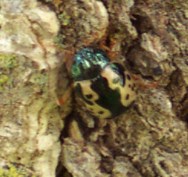

Inset photo: Fire Ant mound. www.forestryimages.org Structural pests that are common to Lyndon B. Johnson National Historical Park area include:
The park pecan orchard was historically treated for:
Currently the park does not manage the pecan orchard for production, so pest management is concerned with maintaining the overall health of the orchard. Outdoor pests associated with ornamentals in the formal landscapes around the park's historic structures include the Gelatinous Whitefly (Aleuroplatus gelatinosus) and Iris Whitefly (Aleyrodes spiraeoides). Exotic outdoor pests include the Crape Myrtle Aphid (Tinocallis kahawaluokalani), San Jose Scale (Quadraspidiotus perniciosi), and Citrus Whitefly (Dialuerodes citri). |
Last updated: February 24, 2015
